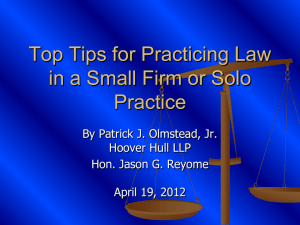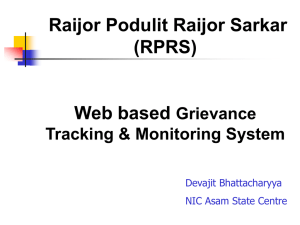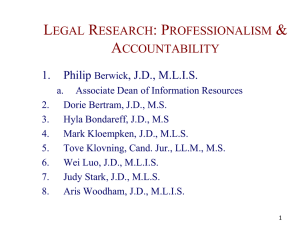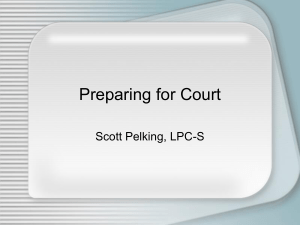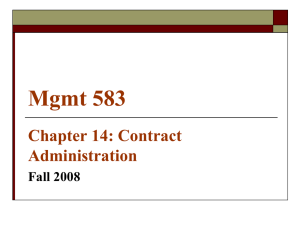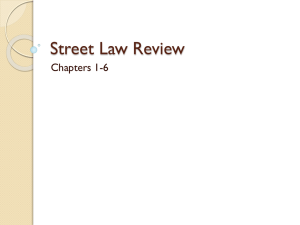Ethical Considerations for the Solo/Small Firm Practitioner
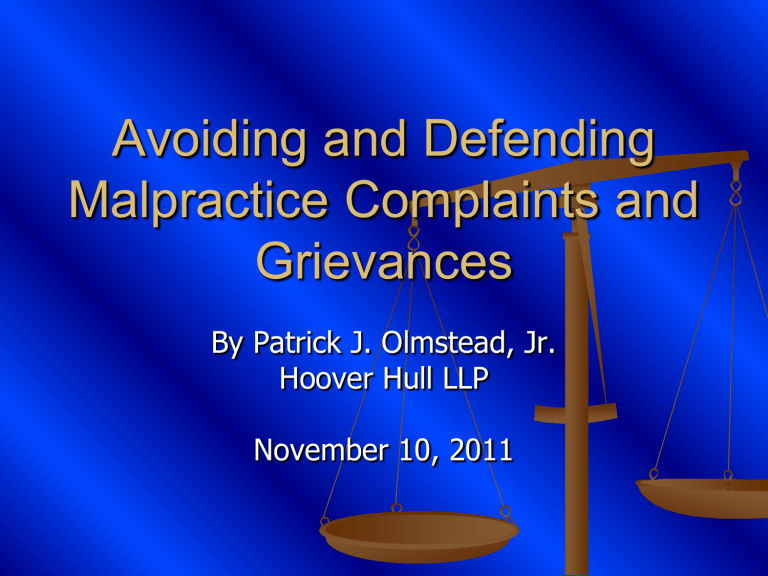
Avoiding and Defending
Malpractice Complaints and
Grievances
By Patrick J. Olmstead, Jr.
Hoover Hull LLP
November 10, 2011
Malpractice Suits and
Grievances
A malpractice suit is a personal injury suit designed to recover monetary damages.
The grievance process is designed to determine the fitness of an attorney to practice and to protect the public and
Courts.
2008-2009 Reporting Period
17,187 active lawyers
1,456 grievances received
949 grievances dismissed
507 requests for response
53 grievances
62 Verified Complaints for Disciplinary
Action
Areas of Practice
Criminal (31%)
Domestic Relations (19%)
Tort (8%)
Bankruptcy (6%)
Contracts (6%)
Probate (4%)
What to do if a Grievance is filed
Contact your insurance carrier or agent
If you do not contact your carrier immediately, they may decline coverage on the grievance as well as subsequent malpractice suit.
The carrier may even provide counsel to represent you in the grievance process.
Consult an attorney
Do not contact your client about dismissing the grievance. Matter of
Ramirez, 853 N.E.2d 121 (Ind. 2006).
Screening Clients
This is your best chance to avoid malpractice suits and grievances.
Conflict Check before meeting.
Make sure you can comfortably handle the representation (both the expertise and time) and the client suits you.
Watch out for:
Unrealistic expectations;
Too emotionally involved;
Nothing else to do but monitor the litigation;
Overly involved;
Has already had one attorney (this should be a red flag);
Prior history as a litigant.
Prospective Clients
“Duties to Prospective Clients”
Duty to maintain the confidential nature of the communications shared by the prospective clients.
In re Anonymous, 932 N.E.2d 671 (Ind. 2010)
(violated 1.9(c)(2) by disclosing that client was getting divorced) (no exception for public information).
Rule 1.18(d)(2) Safe Harbor.
Independently verify the facts – (proper parties, statute of limitations issues, etc.).
Evaluation Letter
Send a letter informing the client you are assessing whether to accept the representation.
Until you accept the case, in writing make it clear that no attorney-client relationship has been formed and you do not represent them.
Ask them to waive all conflicts in return for your evaluation and make them sign it.
Objective Evaluation
“About half the practice of a decent lawyer consists in telling would-be clients that they are damned fools and should stop.”
Hill v. Norfolk & Western Rwy. Co
.
, 814
F.2d 1192, 1202 (7 th Cir. 1987) (imposing sanctions for frivolous litigation).
Letter Declining Representation
An important tool for defending malpractice suits and grievances is a letter declining representation.
These malpractice lawsuits fall under the category of “no good deed goes unpunished.”
Declination Letter Language
As we discussed in our telephone conversation, no attorney-client relationship was formed.
No duty was owed to perform any research or to do any work.
The confidential nature of the discussion will be maintained.
There are certain notice requirements and statute of limitations issues that may affect the viability of your claim, and you should secure legal counsel. (Do not provide expiration date.)
Avoid such statements as, “if you have any questions, please call me.”
Competence
An attorney must be competent in subject matter of representation to accept the case.
Rule 1.1.
Only one of three options:
Be competent;
Become competent (through research);
Hire competent co-counsel.
You cannot contract a lower standard of care.
Make sure you have a writing documenting your client’s decision not to spend money.
Assisting the Unauthorized Practice of Law
In the Matter of Anonymous, No. 10S00-
1006-DI-288 (Ind. Sept. 3, 2010) (private reprimand) (Indiana attorneys serving as local counsel for out-of-state attorneys are hereby advised of the importance of their duty to ensure complete and timely compliance with all the requirements of
ADR 3(2) [regarding admission].”).
pro hac vice
Contracting Staff Counsel
ABA Formal Op. 00-420 (2000) (“[A] lawyer may … add a surcharge on amounts paid to a contract lawyer when services provided by the contract lawyer are billed as legal services” but no surcharge if billed as an expense).
See also ABA Formal Op. 88-356 (1988)
(disclosure requirements for co-counsel).
Clarify the Client and Conflicts
Who is your client? Make that clear!
Rule 1.18.
Joint representation can also cause a conflict of interest. ABA Formal Opinion 06-438, Feb. 10,
2006.
Personal interests? Positional conflicts?
Draft Conflict Waivers and recommend independent counsel to review the conflict waiver.
Diligence and Adequate
Communication
Most common disciplinary complaints
Rule 1.3 regarding diligence and promptness
1.4(a) keeping client adequately informed
1.4(b) explaining matter sufficiently to client
Do not accept cases your office cannot handle.
Do not procrastinate, use your calendar.
Keep copies of all communications (includes notes of voicemails from and phone conferences with clients).
Establish guidelines for communication – e-mail, letter?
How often?
Keep client reasonably informed – provide objective analysis of case (including weaknesses and worst case recoveries).
Engagement Letters
You must draft a careful and proper engagement letter. Very important tool for defending malpractice complaints and grievances.
Written fee agreements are increasingly recommended for all cases.
Scope of Engagement
Carefully describe the scope of your services to limit your responsibility. RPC
1.1, 1.2. Flatow v. Ingalls, 932 N.E.2d
726 (Ind. Ct. App. 2010),
trans. denied.
What matter does the engagement cover?
Scope of services in the matter?
What are you not doing?
(Ex: Corporate formation only. Separate engagement for further legal work.)
Litigation Hold Letters
Increasing emphasis.
1100 West, LLC v. Red Spot Paint & Varnish Co.,
Inc., 2009 WL 1605118 (S.D. Ind. 2009) (default judgment due to discovery abuse and sanctions against client and attorneys) (“BME compounded the problem by, like a chameleon, becoming indistinguishable from its client and allowing Red
Spot … to evade the truth.”).
Advice on Billing and Fees
Non-refundable retainer is an anachronism.
Matter of O’Farrell, 942 N.E.2d 799 (Ind. 2011)
(public reprimand for non-refundable flat fees).
You cannot stop rendering services until you receive payment.
Rule 1.4(a), duty to keep client reasonably informed, likely includes estimating costs versus likely recovery. (Ability to collect?)
Must Explain Fees
In re Lauter, 933 N.E.2d 1258 (Ind. 2010).
Lauter agreed to $750 fee to take case through EEOC process. EEOC found no probable cause. Suit filed anyway, and client paid additional $4,250. Recovered
$75,000. So, client grieved Lauter. Public reprimand for not disclosing “what the additional retainer would be or how it would be determined.”
Id
. at 1262.
Written Fee Agreements
Clauses you should consider include:
The client shall pay reasonable costs and expenses regardless of recovery in suit.
Representation will not begin until the attorney receives payment in full of the advance fee.
The client consents to the attorney’s withdrawal in the event the client does not promptly pay the attorney’s bill. Fidelity Nat’l, 310 F.3d 537 (7th Cir.
2002) (permitting attorney to withdraw).
Attorney shall have a lien on the proceeds and the file until paid in full.
1.5 Reasonable Fees and Billing
Factors Regarding Whether Fee is Reasonable
Taking retainer & performing “no meaningful service”
Collecting private fee when paid by government.
Matter of Brown (2006) (60 day suspension for taking a fee as a public defender).
Taking a large percentage of initial payment in a structured settlement
Charging a fee for withdrawing from the case.
Charging fees after client has terminated attorneyclient relationship.
Billing client for work done but not provided to client.
Billing (Cont’d)
Send interim billing to keep the client informed.
Matter of Areaux (2005) (public reprimand where final bill of $12,195.18 exceeded $4,000 estimate).
You cannot stop rendering services until you receive payment. (You must get approval to withdraw.)
Disclaim personal liability for third party costs.
Kelly v. Levandoski, 875 N.E.2d 850 (Ind. Ct.
App. 2005) (jury ordered attorney to pay towing company $18,827).
Don’t sue your client for fees
90% of fee claims result in a counterclaim for legal malpractice.
Oftentimes, your insurer will ask whether you sue for fees (because it makes you a higher risk).
There is little point in suing a client who cannot pay.
Don’t sue (cont’d)
Matter of Beacham, 934 N.E.2d 735 (Ind.
2010). In 2003, agreed to nonrefundable retainer of $5,000, plus the greater of
$200/hr. or 25%. Work “provided no value,” and was “of poor quality and rambling.” Final bill of $233,484. Client settled her case for $20,000. Beacham sued for fees (in Indiana), defaulted client, forcing her into bankruptcy.
Timesheets
Always keep track of your time, regardless of the fee arrangement.
They are a valuable tool for defending malpractice complaints and grievances.
They are admissible as business records.
Think “defensively” when writing your narrative.
Explain: who, what, why.
“Clients lie, and clients die.” Olmstead.
Letter Terminating Representation
Never assume the attorney-client relationship has been terminated. Write a letter.
Letter should establish the date of termination.
Letter should be short but designed to cover you in case of subsequent lawsuit or grievance.
Letter should inform client of potential lien against client’s file and proceeds of the litigation as security for your fees and expenses.
Helps defend claims of continuous representation .
Trust Accounts
An increasing point of emphasis is the proper maintenance of trust accounts.
Separate ledger for each client.
Each client must have balance above $1.
Trust Accounts (Cont’d)
Matter of Goldberg, 2011 WL 3793677 (Aug. 24,
2011) (failed to keep adequate records, failed to hold funds in trust, used some fund to pay filing fees for other client) (90 days, 30 served with 60 stayed subject to 2 years of probation).
Matter of Smith (2006) (60 days because he didn’t use attorney trust account or IOLTA account for awhile and then mismanaged the accounts he opened).
Collecting on Your Fees (1.8)
Four Winds, LLC v. Smith & DeBonis, 854
N.E.2d 70, 75 (Ind. Ct. App. 2006)
(approving of termination clause which rendered the client liable for attorney fees upon discharge and retaining lien on file).
Estate of Johnson, 855 N.E. 2d 686, 693
(Ind. Ct. App. 2006) (lien on proceeds).
Grimes v. Crockrom, 947 N.E.2d 452 (Ind.
Ct. App. 2011) (valid retaining lien on medical records).
Arranging for a Surrogate Attorney
Lawyers should have an agreement with another local attorney to step in for each other in an emergency. This is a point of increasing emphasis with the Disciplinary
Commission.
Prepare arrangement on how to split fees.
Make sure surrogate is competent to handle the case.
What to Do When You Mess Up
Notify your insurance carrier/agent.
Prepare a letter explaining the mistake made and what can be done about it.
Owning up to your mistake immediately can mitigate your damages.
If any questions, contact:
Patrick J. Olmstead, Jr.
Hoover Hull LLP
111 Monument Cir., Ste. 4400
P.O. Box 44989
Indianapolis, IN 46204-0989
(317) 822-4400 polmstead@hooverhull.com
©2011
